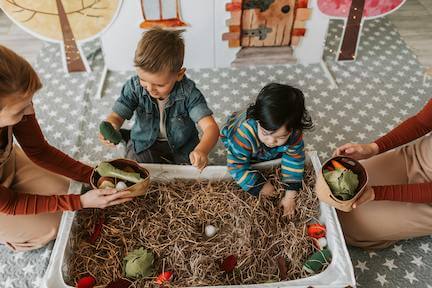Language development is a crucial aspect of the early years of life; it forms the foundation for communication, social skills, and learning in general. At this stage little children are learning to interact with other children. We, as teachers and parents, as well as any other person who interacts with them, play a very important role in helping to acquire language skills. Appropriate behavior needs to be taught and learned.
Children, when they start talking and when they try to communicate, don’t have the knowledge of words to be able to express what they need or want. We need to be sensitive to their nonverbal attempts to help them communicate by giving them the appropriate words to be used.
ACT AS A TRANSLATOR BETWEEN CHILDREN
When children are interacting with their peers, we can play the role of “translators” and express what one child is trying to tell the other. “It looks like Sara is trying to play with you. Look, she is sharing her doll with you.” By saying this, you are not only giving the child the words to use, but also you are helping them to have a conversation and encouraging them to be friendly with each
other.
GIVE EXAMPLES OF HOW TO INTERACT
You, as a parent, can observe your child when he/she is playing, and you can give them examples of how they can interact. By commenting on what other children are doing, you can include the other child in the conversation and facilitate peer interaction. If one child is by himself, you can suggest inviting him/her to play, maybe offer a ball or a toy to play with your child. “It looks like Julia is by herself; maybe we can invite her to play with us?” By doing so, you are encouraging cooperation, learning to share, and peer interactions that will translate into friendships.
ENCOURAGE RESPONSIVENESS
Providing children with ways to communicate and asking them open-ended questions will encourage them to think and respond, “Let’s eat some cookies with milk. Ask Sara if she wants chocolate cookies or vanilla cookies?” Give your child time to respond during conversations. Every child is unique and develops at their own pace. Be consistent with your interactions and be a “model and translator” to them; your attention and responsiveness are very important to foster your child’s language growth and to develop social skills to have better peer interactions, to be more independent, and to be able to have problem-solving skills as well.
PROVIDE THE RIGHT ENVIRONMENT
Create a language-rich environment, have a lot of books, music, and meaningful conversations, describe everything to them, and celebrate any milestone, and you will see the results in your child’s language development and their interactions with other children.
ABOUT THE AUTHOR
Monica Valdes was born in Mexico City, where she earned a bachelor’s degree in Elementary Education. With over 35 years of experience in the education field, Monica is deeply passionate about the profound impact educators have on a child’s early years. After moving to Miami, she began working as a preschool teacher while furthering her education and actively serving her community. Monica holds a Child Development Associate (CDA) credential and a Director’s Credential with a VPK endorsement. For the past 20 years, she has worked in educational administration, a role that allows her to stay closely connected with children, mentor and inspire teachers, and build strong relationships with parents. Her dedication to early childhood education continues to drive Monica to create nurturing, enriching environments where young learners can thrive.
Related Articles:
- Fortifying Parents’ Attitudes About Children’s Learning
- Guiding Through Play: Help Your Child Develop Key Skills
Cover Photo by Vlada Karpovich

